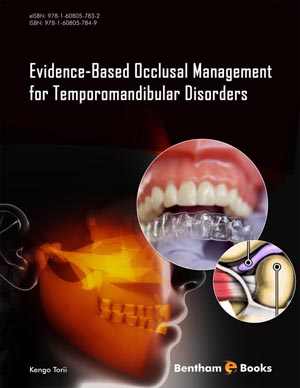Prevalence of Temporomandibular Disorders
Page: 3-19 (17)
Author: Kengo Torii
DOI: 10.2174/9781608057832115010003
PDF Price: $15
Abstract
It has been estimated that the prevalence of temporomandibular disorders is in 20-30% of population, but the need for treatment is in less than 5%. However, early treatment is needed for individuals with limitation of opening mouth or pain during mandibular function.
Causes and Contributing Factors of Temporomandibular Disorders
Page: 20-34 (15)
Author: Kengo Torii
DOI: 10.2174/9781608057832115010004
PDF Price: $15
Abstract
Various contributing factors for temporomandibular disorders have been enumerated; occlusal factors, trauma, habits (bruxism, lip-, tongue-, and nail-biting) and psychological factors. However, prominent factors have not been found.
Occlusion and Temporomandibular Disorders
Page: 35-53 (19)
Author: Kengo Torii
DOI: 10.2174/9781608057832115010005
PDF Price: $15
Abstract
The relation between retruded contact position (RCP), oblique slide from RCP to intercuspal position (ICP), and temporomandibular disorders (TMDs) has not been demonstrated. Recently, occlusal discrepancy between habitual occlusal position (HOP) and bite plate-induced occlusal position (BPOP) has been reported to be related with sign (TMJ clicking) of TMD in a cross-sectional study. And elimination of the occlusal discrepancy is inferred to cure TMDs.
Reference Position for Occlusal Analysis and Equilibration
Page: 54-74 (21)
Author: Kengo Torii
DOI: 10.2174/9781608057832115010006
PDF Price: $15
Abstract
The value of retruded contact position (RCP) as a reference position for an occlusal analysis has not been demonstrated. On the other hand, muscular contact position (MCP) has been found to be important for a reference position in occlusal analysis and occlusal equilibration.
Reproducibility of the Muscular Contact Position
Page: 75-97 (23)
Author: Kengo Torii
DOI: 10.2174/9781608057832115010007
PDF Price: $15
Abstract
The reproduction of a habitual (natural) closing movement is considered to be important because this closing movement ends at the muscular contact position (MCP), otherwise known as the intercuspal position (ICP). This closing movement was originally regarded as a hinge-like movement. However, since it has been demonstrated to be a bodily movement, that is, a vertical movement, this vertical movement can be reproduced on an articulator.
Various Therapies Prior to Occlusal Equilibration
Page: 98-122 (25)
Author: Kengo Torii
DOI: 10.2174/9781608057832115010008
PDF Price: $15
Abstract
There have been various therapies to relieve the symptoms of temporomandibular disorders. These therapies are required to relax the masticatory muscles and to precisely analyze, and equilibrate an occlusion in the muscular contact position (MCP).
Occlusal Equilibration in the Muscular Contact Position
Page: 123-149 (27)
Author: Kengo Torii
DOI: 10.2174/9781608057832115010009
PDF Price: $15
Abstract
Occlusal equilibration in the muscular contact position (MCP) is required to obtain bilateral occlusal contact in the MCP. It is essential to equilibrate an occlusion on dental casts mounted on an articulator with bite plate-induced occlusal position wax record (BPOP record).
Possible Mechanism of Temporomandibular Disorders
Page: 150-171 (22)
Author: Kengo Torii
DOI: 10.2174/9781608057832115010010
PDF Price: $15
Abstract
Regarding the mechanism of temporomandibular disorders (TMDs), TMD pain including muscle tenderness to palpation is considered to be caused by masticatory muscle fatigue induced with occlusal discrepancy. Temporomandibualr joint (TMJ) derangement is considered to be occurred due to mandibular displacement from muscular position to habitual position.
Various Symptoms of Temporomandibular Disorders
Page: 172-185 (14)
Author: Kengo Torii
DOI: 10.2174/9781608057832115010011
PDF Price: $15
Abstract
Tension type headache is considered to manifest occur due to hypertension of masticatory muscles induced by occlusal discrepancy. Aural symptoms are also considered to occur due to hypertension of masticatory muscles or fatigue related to them. Burning mouth syndrome and glossodynia are considered to be caused by chorda tympani squeezed between malleus and incus.
Treatment Outcome of Temporomandibualr Disorders
Page: 186-196 (11)
Author: Kengo Torii
DOI: 10.2174/9781608057832115010012
PDF Price: $15
Abstract
Conservative treatments for temporomandibular disorders (TMDs) are symptomatic treatments, and therefore, they cannot completely cure TMDs. The signs and symptoms of TMDs completely disappear by using occlusal equilibration in the muscular contact position (MCP). This is a causal treatment for TMDs. The evaluation of outcome of treatment should be performed to strictly confirm whether or not signs and symptoms have disappeared.
Introduction
Current mainstream treatments for temporomandibular disorders (TMDs) are mainly conservative therapies. However, these conservative treatments are symptomatic treatments, not causal treatments. Therefore, the patients with severe symptoms have not been completely relieved. Evidence-Based Occlusal Management for Temporomandibular Disorders is a concise e-lecture which covers the following points: 1. When do the signs or symptoms of TMD emerge? 2. Should the signs or symptoms be left untreated? 3. When should the treatment start? 4. How should the occlusal discrepancy be examined? 5. How should occlusion at the BPOP (bite plate-induced occlusal position) (muscular contact position) be equilibrated? The e-lecture also demonstrates a positive outcome using causal treatment based on occlusal equilibration in the BPOP based on the evidence of a relationship between occlusal discrepancy and TMD. Therefore, this e-book shares insightful, evidence-based clinical data with interested readers such as dental clinicians and researchers around the world.






















